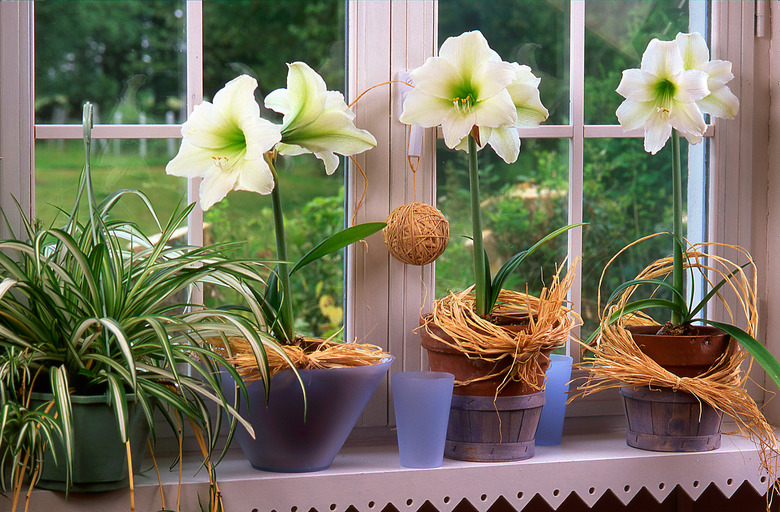Flowers That Look Like Lilies
We may receive a commission on purchases made from links.
The colorful blossoms of lilies (family Liliaceae) fill borders and gardens with vibrant color but are toxic to cats. If you love lilies, there are many other flowers that look like lilies that add color and texture to the landscape. Whether choosing for color, size, bloom time, or your U.S. Department of Agriculture plant hardiness zone, plant them where they receive the appropriate amount of sun and water so you can enjoy them through their entire blooming season.
Amaryllis Family (Amaryllidaceae)
Amaryllis Family (Amaryllidaceae)
The amaryllis family features a number of species and cultivars that resemble lilies, and many are also toxic to cats, dogs, and humans, so use caution where you plant the bulbs. Among these lilylike plants is the belladonna lily (Amaryllis belladonna), also known as the naked lady lily and resurrection lily. The pink trumpet-shaped flowers are similar to the white flowers of the well-known Easter lily (Lilium longiflorum). These large, pink-flowering "lilies" are hardy in USDA zones 7 through 10, while Easter lilies prefer USDA zones 5 through 11.
Like the belladonna lily, the red spider lily (Lycoris radiata) and Guernsey lily (Nerine bowdenii) produce their showy, trumpet-shaped blossoms in mid to late summer, followed by strap-shaped leaves that die back in spring. Both species feature extra-long, spiderlike stamens with flowers ranging from white to yellow to pink, red, or burgundy depending on the cultivar. Red spider lilies produce their 3- to 6-inch-wide flowers in USDA zones 6 through 10, while Guernsey lilies feature smaller 1- to 3-inch-wide blossoms in USDA zones 8 through 10.
Lily of the Nile (Agapanthus africanus) is also a member of the amaryllis family, hardy in USDA zones 8 through 10. The clusters of white, blue, or purple funnel-shaped flowers rise above the mound of grasslike foliage. A number of hybrids are available, ranging from 18-inch-tall dwarf plants to 4-foot-tall cultivars.
Canna Family (Cannaceae)
Canna Family (Cannaceae)
The canna lilies (Canna spp.) are a group of flowering rhizomes that thrive in USDA zones 7 through 10, depending on the species and cultivar. These brightly flowering plants grow from 18 inches to 8 feet tall and up to 6 feet wide. Colorful flowers ranging from pale yellow to brilliant yellow, orange, and burgundy and wide green to bronzed leaves give the garden a tropical flair. While often called "lilies," cannas are not in the lily family and more closely resemble iris flowers than traditional lily species.
Iris Family (Iridaceae)
Iris Family (Iridaceae)
With about 2,200 species, the iris family includes a number of lilylike flowering corms, bulbs, and rhizomes. Among those are the gladiolus species, often called glads or sword lilies. The Abyssinian gladiolus (Acidanthera murielae), also known as the peacock orchid, produces its white flowers with purplish centers in USDA zones 7 through 11. The South African gladiolus species, such as the white- or pale-yellow-flowering marsh Afrikaner (Gladiolus tristis), which grows up to 30 inches tall, and the pale yellow to lilac brown-speckled gladiolus (Gladiolus maculatus) thrive in USDA zones 8 through 10.
If you love the vibrant speckled oranges of the tiger lily (Lilium lancifolium), hardy in USDA zones 3 through 9, but have cats that nibble on your plants, consider planting blackberry lilies (Belamcanda chinensis, also known as Iris domestica) or tiger flowers (Tigridia pavonia). Blackberry lilies feature flowers similar to tiger lilies, producing 2-inch-wide yellow to orange flowers with darker speckles rising above 18-inch-tall swordlike leaves in a traditional iris-type fan. The prolific but short-lived white-, yellow-, pink-, or red-speckled blossoms of the Mexican tiger flower range from 3 to 6 inches wide with 18- to 24-inch-tall blade-shaped leaves. These lilylike flowers are hardy in USDA zones 5 through 10 and 8 through 10, respectively.
References
- North Carolina Extension Gardener Plant Toolbox: Amaryllis belladonna
- Wisconsin Horticulture Division of Extension: Easter Lily, Lilium longiflorum
- Missouri Botanical Garden: Lycoris radiata
- North Carolina Extension Gardener Plant Toolbox: Nerine
- Missouri Botanical Garden: Agapanthus (Group)
- Missouri Botanical Garden: Canna (Group)
- Longfield Gardens: All About Acidanthera
- Pacific Bulb Society: Winter Rain Gladiolus A-Z
- Wisconsin Horticulture Division of Extension: Blackberry Lily, Belamcanda chinensis or Iris domestica
- Plant Care Today: Mexican Tiger Flower: How To Care for the Tigridia pavonia
- UC Davis Veterinary Medicine: Lily Toxicity in Cats
- Britannica: Iridaceae Plant Family
